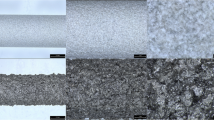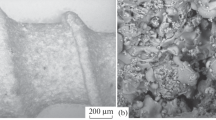Abstract
The current study evaluates the in vivo response to free form fabricated cobalt chromium (CoCr) implants with and without hydroxyapatite (HA) plasma sprayed coatings. The free form fabrication method allowed for integration of complicated pyramidal surface structures on the cylindrical implant. Implants were press fit into the tibial metaphysis of nine New Zealand white rabbits. Animals were sacrificed and implants were removed and embedded. Histological analysis, histomorphometry and electron microscopy studies were performed. Focused ion beam was used to prepare thin sections for high-resolution transmission electron microscopy examination. The fabricated features allowed for effective bone in-growth and firm fixation after 6 weeks. Transmission electron microscopy investigations revealed intimate bone-implant integration at the nanometre scale for the HA coated samples. In addition, histomorphometry revealed a significantly higher bone contact on HA coated implants compared to native CoCr implants. It is concluded that free form fabrication in combination with HA coating improves the early fixation in bone under experimental conditions.








Similar content being viewed by others
References
Sundfeldt M, Carlsson LV, Johansson CB, Thomsen P, Gretzer C. Aseptic loosening, not only a question of wear: a review of different theories. Acta Orthop. 2006;77(2):177–97.
Webster TJ, Ejiofor JU. Increased osteoblast adhesion on nanophase metals: Ti, Ti6Al4V and CoCrMo. Biomaterials. 2004;25:4731–9.
Rahaman MN, Yao A, Bal BS, Garino JP, Ries MD. Ceramics for prosthetic hip and knee joint replacement. J Am Ceram Soc. 2007;90(7):1965–88.
Sotereanos NG, Engh CA, Glassman AH, Marcalino GE, Engh CA Jr. Cementless femoral component should be made from cobalt chrome. Clin Orthop Relat Res. 1995;313:146–53.
Walsh WR, Svehla MJ, Russell J, Saito M, Nakashima T, Gillies RM, Bruce W, Hori R. Cemented fixation with PMMA or Bis-GMA resin hydroxyapatite cement: effect of implant surface roughness. Biomaterials. 2004;25:4929–34.
Hunt JA, Callaghan JT, Sutcliffe CJ, Morgan RH, Halford B, Black RA. The design and production of Co-Cr alloy implants with controlled surface topography by CADCAM method and their effects on osseointegration. Biomaterials. 2005;26(29):5890–7.
Villar RN. Non-cemented hip prothesis. Br Med J (Clin Res Ed). 1985;291:53.
Gao F, Henricson A, Nilsson KG. Cemented versus uncemented fixation of the fermoral component of the NexGen CR total knee replacement in patients younger than 60 years: a prospective randomised controlled RSA study. Knee. 2009;16:200–6.
Bojescul JA, Xenos JS, Callaghan JJ, Savory CG. Results of porous-coated anatomic total hip arthroplasty without cement at fifteen years: a concise follow-up of a previous report. J Bone Joint Surg Am. 2003;85:1079–83.
Ong JL, Chan DCN. Hydroxyapatite and their use as coatings in dental implants: a review. Crit Rev Biomed Eng. 2000;28(5–6):667A–707A.
Chambers B, St. Clair SF, Froimson MI. Hydroxyapatite-coated tapered cementless femoral components in total hip arthroplasty. J Arthroplast. 2007;22(4):71–4.
Hench LL. Biomaterials: a forecast for the future. Biomaterials. 1998;19(16):1419–23.
Donath K, Breuner G. A method for the study of decalcified bones and teeth with attached soft tissues. The Sage-Schliff(sawing and grinding) technique. J Oral Pathol. 1982;11:318–26.
Jarmar T, Palmquist A, Brånemark R, Hermansson L, Engqvist H, Thomsen P. Technique for preparation and characterization in cross-section of oral titanium implant surfaces using focused ion beam and transmission electron microscopy. J Biomed Mater Res. 2008;87A:1003–9.
Malmström J, Adolfsson E, Emanuelsson L, Thomsen P. Bone ingrowth in zirconia and hydroxyapatite scaffolds with identical macroporosity. J Mater Sci Mater Med. 2008;19:2983–92.
Thomsen P, Malmström J, Emanuelsson L, René M, Snis A. Electron beam-melted, free-form-fabricated titanium alloy implants: material surface characterization and early bone response in rabbits. J Biomed Mater Res. 2009;90B:35–44.
Curodeau A, Sachs E, Caldarise S. Design and fabrication of cast orthopedic implants with freeform surface textures from 3-D printed ceramic shell. J Biomed Mater Res. 2000;53:525–35.
Melican MC, Zimmerman MC, Dhillon MS, Ponnambalam AR, Curodeau A, Parsons JR. Three-dimensional printing and porous metallic surfaces: a new orthopedic application. J Biomed Mater Res. 2001;55:194–202.
Mohammadi S, Esposito M, Hall J, Emanuelsson L, Krozer A, Thomsen P. Long-term bone response to titanium implants coated with thin radiofrequent magnetron sputteres hydroxyapatite in rabbits. Int J Oral Maxillofac Implants. 2004;l19:498–509.
Wennerberg A, Hallgren C, Johansson C, Danelli S. A histomorphometric evaluation of screw-shaped implants each prepared with two surface roughnesses. Clin Oral Implants Res. 1998;9:11–9.
Wennerberg A, Albrektsson T, Andersson B, Krol JJ. A histomorphometric and removal torque study of screw-shaped titanium implants with three different surface topographies. Clin Oral Implants Res. 1995;6:24–30.
Brånemark R, Ohrnell LO, Nilsson P, Thomsen P. Biomechanical characterization of osseointegration during healing: an experimental in vivo study in the rat. Biomaterials. 1997;18(14):969–78.
Engqvist H, Botton GA, Couillard M, Mohammadi S, Malmström J, Emanuelsson L, Hermansson L, Phaneuf MW, Thomsen P. A novel tool for high-resolution transmission electron microscopy of intact interfaces between bone and metallic implants. J Biomed Mater Res. 2006;78A:20–4.
Porter A, Patel N, Brooks R, Best S, Rushton N, Bonfield W. Effect of carbonate substitution on the ultrastructural characteristics of hydroxyapatite implants. J Mater Sci Mater Med. 2005;16(10):899–907.
Porter AE, Buckland T, Hing K, Best SM, Bonfield W. The structure of the bond between bone and porous silicon-substituted hydroxyapatite bioceramic implants. J Biomed Mater Res. 2006;78A:25–33.
Malmström J, Slotte C, Adolfsson E, Norderyd O, Thomsen P. Bone response to free form-fabricated hydroxyapatite and zirconia scaffolds: a histological study in the human maxilla. Clin Oral Implants Res. 2009;20:379–85.
Haynes DR, Crotti T, Haywood MR. Corrosion of and changes in biological effects of cobalt chrome alloy and 316L stainless steel prosthetic particles with age. J Biomed Mater Res. 2000;49:167–75.
Acknowledgments
European Commission Project Hiped Hips 2 (Proposal number CRAFT – 1999 – 70587), VINNOVA VinnVäxt Program Biomedical Development in Western Sweden, the Swedish Research Council (grant K2006-73X-09495-16-3), the Institute of Biomaterials and Cell Therapy (IBCT), the Göran Gustafsson Foundation, and Teknimed are gratefully acknowledged.
Author information
Authors and Affiliations
Corresponding author
Rights and permissions
About this article
Cite this article
Grandfield, K., Palmquist, A., Gonçalves, S. et al. Free form fabricated features on CoCr implants with and without hydroxyapatite coating in vivo: a comparative study of bone contact and bone growth induction. J Mater Sci: Mater Med 22, 899–906 (2011). https://doi.org/10.1007/s10856-011-4253-3
Received:
Accepted:
Published:
Issue Date:
DOI: https://doi.org/10.1007/s10856-011-4253-3




